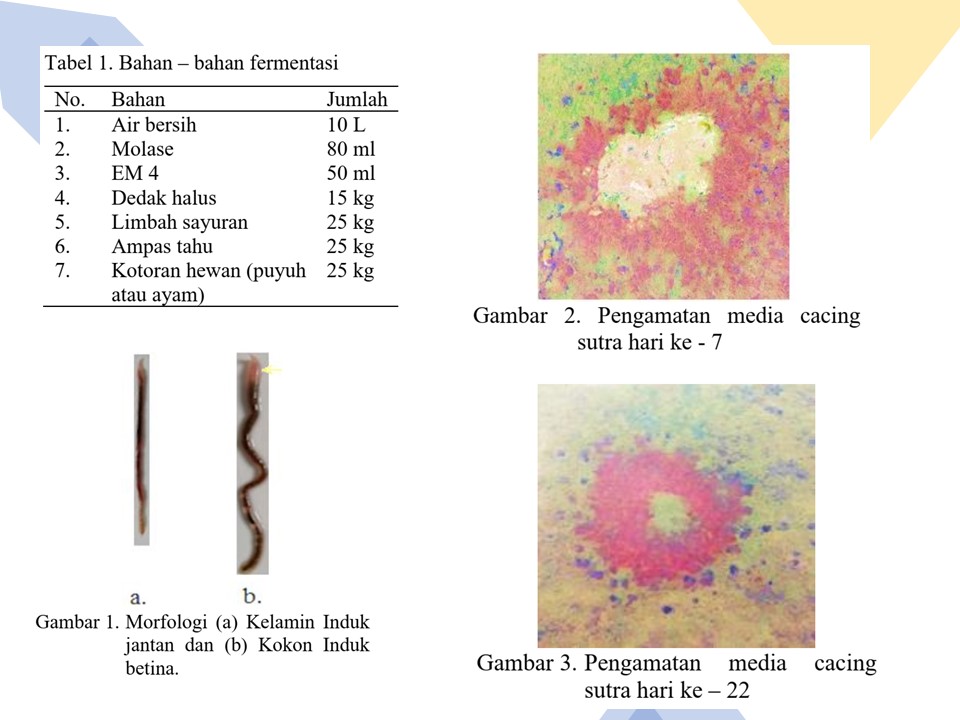Technology for Cultivating Silkworms (Tubifex sp.) at the Sukabumi Freshwater Aquaculture Center, West Java
DOI:
https://doi.org/10.46252/jsai-fpik-unipa.2023.Vol.7.No.2.280Keywords:
Growth, Natural Food, SilkwormAbstract
Feed is divided into two, namely natural feed and artificial feed. Natural feed is feed given to the larval stage and is the main source of protein for larvae. Silk worms (Tubifex sp.) is one of the natural fish food that contains good nutrition for fish growth. The purpose of this activity is to know the technology of cultivating silk worms (Tubifex sp.) at the Center for Freshwater Aquaculture, Sukabumi, West Java Province. The method used in this activity is field observation and collection of primary and secondary data. The stages of implementing the activities include preparation of containers, manufacture of culture media, stocking of silk worms and maintenance. Parameters observed were silkworm morphology, individual weight, absolute weight growth and specific growth rate and water quality presented in tabular form and processed descriptively. Based on worm rearing data, the specific growth rate was 17.73% day-1 and the weight growth was 249.12 g.
Downloads
References
Agustina, D., & Mukti, R. C., (2021). The influence of feeding combination silkworm (Tubifex sp.) with commercial feed on growth performance of catfish (Clarias sp.). Acta Aquatica: Aquatic Sciences Journal, 8(2), 74-77.
Buwono, (2000). Kebutuhan Asam Amino Essensial dalam Ransum Pakan Ikan. Yogyakarta:Kanisius.
Chilmawati, D. Suminto & Tristiana Y., (2014). Pemanfaatan fermentasi limbah organik ampas tahu, bekatul dan kotoran ayam untuk peningkatan produksi kultur dan kualitas cacing sutera (Tubifex sp). Journal of Aquacultur Management and Technology, 3 (4): 186-201.
Dahelmi, (2011). Usaha Pembenihan Ikan Hias Air Tawar. Jakarta:Penebar Swadaya.
Effendie, M.I. (1997). Metode Biologi Perikanan. Bogor: Yayasan Dewi Sri.
Efendi, M., (2013). Beternak cacing sutera cara modern. Jakarta: Penebar Swadaya.
Fajri, N. W., Suminto & Hutabarat. J., (2014). Pengaruh penambahan kotoran ayam, ampas tahu dan tepungtapioka dalam media kultur terhadap biomassa, populasi dan kandungan nutrisi cacing sutera (Tubifex sp.). Journal of Aquaculture Management and Technology, 3(4): 101 - 108.
Febrianti, D., (2004). Pengaruh Pemupukan Harian Dengan Kotoran Ayam Terhadap Pertumbuhan Populasi dan Biomassa Cacing Sutera (Limnodrillus). Skripsi. Institut Pertanian Bogor.
Fisesa, D. E., Setyobudiandi, I., & Krisanti, M., (2014). Kondisi perairan dan struktur komunitas makrozoobentos di Sungai Belumai Kabupaten Deli Serdang Provinsi Sumatera Utara. Jurnal Depik, 3 (1), 1-9.
Husna H. (2017). Biologi Pakan Alami. SP Genius.
Lukito, A., & Prayugo, S., (2007). Panduan Lengkap Lobster Air Tawar. Jakarta: Penebar Swadaya.
Masrurotun, Suminto & Johannes, H., (2014). Pengaruh penambahan kotoran ayam, silase ikan runcah dan tepung tapioka dalam media kultur terhadap biomassa,populasi dan kandungan nutrisi cacing sutera (Tubifex sp.). Journal ofAquaculture Management and Technology, 3 (4), 151-157.
Mewekani, S., (2019). Analisis perkembangbiakan cacing rambut (Tubifex sp.) pada berbagai media tumbuh. Jurnal Tabura Perikanan dan Kelautan, 1 (1).
Nurfitriani, L., Suminto & Hutabarat, J., (2014). Pengaruh penambahan kotoran ayam, ampas tahu dan silase ikan rucah dalam media kultur terhadap biomassa, populasi dan kandungan nutrisi cacing sutra. Journal of Aquaculture Management and Technology, 3(4):109-117.
Ruhiyat, A., (2018). Teknik Budidaya Cacing Sutra (Tubifex sp.) di Balai Besar Perikanan Budidaya Air Tawar (BBPBAT) Sukabumi. Jawa Barat.
Suharyadi, (2012). Studi Pertumbuhan Dan Produksi Cacing Sutera (Tubifex Sp.) Dengan Pupuk Yang Berbeda Dalam Sistem Resirkulasi. Tesis. Universitas Terbuka.
Supriyono, E., Pardiansyah, D., Putri, D.S., Djokosetianto, D. (2015). Perbandingan jumlah bak budidaya cacing sutra (Tubificidae) dengan memanfaatkan limbah budidaya ikan lele (Clarias sp.) sistem intensif terhadap kualitas air ikan lele dan produksi cacing sutra. Jurnal Depik, 1(4).
Wahyu, B. B., (2013). Pemanfaatan campuran limbah padat (sludge) pabrik kertas dan kompos sebagai media budidaya cacing sutra (Tubifex sp). Journal of Chemistry, 2(1).

Downloads
Published
How to Cite
Issue
Section
License
Copyright (c) 2023 Alni Nuraisyah, Boedi Rachman, Retno Cahya Mukti

This work is licensed under a Creative Commons Attribution-ShareAlike 4.0 International License.


















